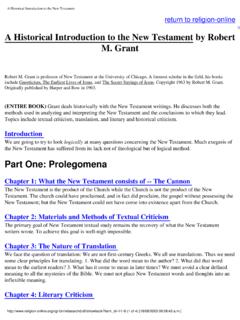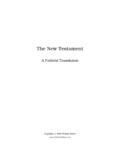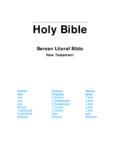Transcription of How the New Testament Canon was Formed - Church History 101
1 How the New Testament Canon was Formed Baker , Ecclesiastical History 2008. Introduction How was the New Testament Formed ? This is the most commonly asked question directed at me when I speak on university campuses. This is a critical question because the Church has always believed that the documents found in the New Testament are inspired writings and the most important source documents for the life, death, and resurrection of Jesus Christ (and Christian doctrine). I have always been told that the early Church fathers used a set of criteria in their decisions regarding the formation of the New Testament Canon . Something like this: - the author must have either been an apostle or the close associate of an apostle - the document cannot contradict other inspired writings with respect to doctrinal teaching - the document must share the overall feel and character of other inspired writings, AND.
2 - it must have been cited by early Christian writers and be accepted by the majority of churches Although these criteria sound reasonable, one cannot find such a clearly described methodology like this in the patristic writings, nor in any council Canon prior to the late fourth century. Many early writings were accepted as inspired by some Church fathers, yet failed to meet one or more of these conditions. Some of the documents that made it into the New Testament fail in one or more of these guidelines the Revelation of John had very little support in the Eastern Church even into the late fourth century. I have also always heard that the New Testament Canon was established at a Church council. Although the exact list of New Testament documents was confirmed at the third Synod of Carthage (397 AD), this was a relatively small regional council and by this time the 27 New Testament documents had already been agreed upon by most of the Church .
3 A Natural Delivery The New Testament was NOT dropped from heaven. The New Testament was NOT delivered by an angel. The New Testament was NOT found in a farmer's field like the Book of Mormon. The New Testament was NOT suddenly discovered in a clay jar with 27 books intact like the Dea Sea Scrolls or the Nag Hammadi texts. 2. The New Testament Canon developed, or evolved, over the course of the first 250-300. years of Christian History . If the New Testament had been delivered by an angel, or unearthed as a complete unit it would not be as believable. Part of the historical validity of the New Testament comes from the fact that we can trace its development. The fact that this development is not as precise nor as clean as we might like makes it far more historically reliable. Oral Tradition Oral tradition was the normal mode for communicating the teachings of a master in the ancient world.
4 For one thing, before the use of papyrus was widespread writing was both clumsy and expensive. Using a stylus on a clay tablet worked, but once the clay dried no corrections or edits could be made. Writing on a scroll made of an animal skin was certainly an improvement, but was still limited. The widespread use of papyrus for the ancient world was like the coming of the internet in the modern world - a virtual explosion of written communication began. Even after respected teachings began to circulate in written form ancient writers continued to be skeptical of using a written format. There was a sense that it fell far short for the communication of treasured knowledge. Church historian Eusebius relates this thinking from the fragments of Papias, But I will not hesitate also to set down for thy benefit, along with the interpretations, all that ever I carefully learnt and carefully recalled from the elders, guaranteeing its I supposed that things out of books did not profit me so much as the utterances of a voice which liveth and abideth.
5 ,3-4. Irenaeus ( ,3-4) quotes another passage from Papias where the author tells us that he knew the apostle John. This represents one of the earliest references to an early oral tradition within Christianity - Papias is writing down what he remembered hearing from the mouth of John, Polycarp, and others - so he is writing down oral tradition. Oral Tradition and the Words of Jesus The words of Jesus were recognized as inspired very soon after the resurrection, yet it was 2-3 decades before his words were circulated in written form. We have one clear example of oral tradition when Paul is addressing the Ephesian elders, 3. In everything I did, I showed you that by this kind of hard work we must help the weak, remembering the words the Lord Jesus himself said: It is more blessed to give than to receive.' - Acts 20:35. This citation is especially interesting since Luke, the author of Acts, does not record this saying in his own gospel.
6 In fact, this agrapha (the Greek word unwritten ) does not appear in any of the four canonical gospels and is a witness to the sayings of Jesus being transmitted in an oral tradition. Many Christian scholars disagree with the theory that the sayings of Jesus were initially transmitted in an oral tradition. The concern is that this would threaten the integrity of his message, and thus threaten the validity of the gospel tradition. But the task for the historian is to present the evidence as objectively as possible, always acknowledging that we are working with theories of events that happened 2,000 years ago for which we do not have ALL the evidence. Probably as early as the late 40's the oral traditions that carried the words of Jesus began to be put into writing. This was probably done to protect the integrity of his message. The Nag Hammadi texts seem to shed light on this phase of the gospel development.
7 The Nag Hammadi Library is a collection of thirteen ancient books, containing over fifty texts, discovered in the Egyptian desert in 1945. These books were sealed in a large clay jar and found by some peasant farmers. The story of this discovery is very interesting an accurate account can be found in summary form online at Within the Nag Hammadi texts is a Gospel of Thomas - this gospel is basically a collection of sayings and stories, not written with any recognizable chronological or thematic order. Some of the sayings closely parallel sayings found in the synoptic gospels (Matthew, Mark, and Luke) - Saying 9, for example is the parable of the sower. Yet others are not only different, but bizarre. Just one example will serve to make the point: Jesus said, This heaven will pass away, and the one above it will pass away. The dead are not alive, and the living will not die.
8 In the days when you consumed what is dead, you made it what is alive. When you come to dwell in the light, what will you do? On the day when you were one you became two. But when you become two, what will you do? Gospel of Thomas, Saying 11. 4. It is likely that early Christian leaders began to hear odd sayings like this one attributed to Jesus and determined that an authoritative set of sayings needed to be recorded. Most scholars believe that Mark's gospel was the first of the four New Testament gospels written, followed by Matthew and Luke. The dates given vary widely from the early 60's (for Mark) into the 80's (for Luke). The difficulty with dating comes from the fact that early writers, like Paul for example, do not quote any of the four gospels. Clear citations do not begin to appear until the early second century. Even more liberal scholars would not suggest a second century date for the synoptic gospels, thus the lack of quotations are attributed to a slow pace for copying and circulating these documents.
9 Papyrus does not become widely and commonly used outside the Egyptian region until the second century. The earliest non-New Testament Christian documents (Barnabas, 1 Clement, and The Shepherd of Hermas) cite the Old Testament as scripture and only make allusions to New Testament texts. Ignatius of Antioch (107-120 AD) is full of allusions to, and paraphrases of, New Testament texts, but it is only when we come to the second century apologists that verified quotations from what we now call New Testament texts begin to be common. Marcion and the Four Gospel Tradition In the 140's Marcion (who was deemed a heretic) constructed his own Canon which included most of Paul's letters in edited form, along with Luke's gospel. Marcion rejected the other gospels as having been tainted by the Jews. This list by Marcion is the first known listing of what is called a New Testament Canon and helped to push the early Church to develop an authoritative list of inspired writings.
10 Second century Church father Justin Martyr does not cite any New Testament writing by name, but he designates his several New Testament citations with it is recorded, or the memoirs of the apostles. He does, however, refer to the Gospels, . For the apostles, in the memoirs composed by them, which are called Gospels, have thus delivered unto us what was enjoined upon them; that Jesus took bread, and when He had given thanks, said, This do ye in remembrance of First Apology 66. Around 170-175 AD Tatian, a disciple of Justin, created a harmony of the four orthodox gospels known as the Diatessaron. This text was accepted in some circles, even being used to replace the four gospels, but this success was short lived. What this 5. harmony reveals, however, is that the Church was beginning to recognize only four gospels. The four gospels are confirmed by Irenaeus of Lyons in Against the Heresies, From this it is clear that the Word, the artificer of all things, being manifested to men gave us the gospel, fourfold in form but held together by one Spirit.






